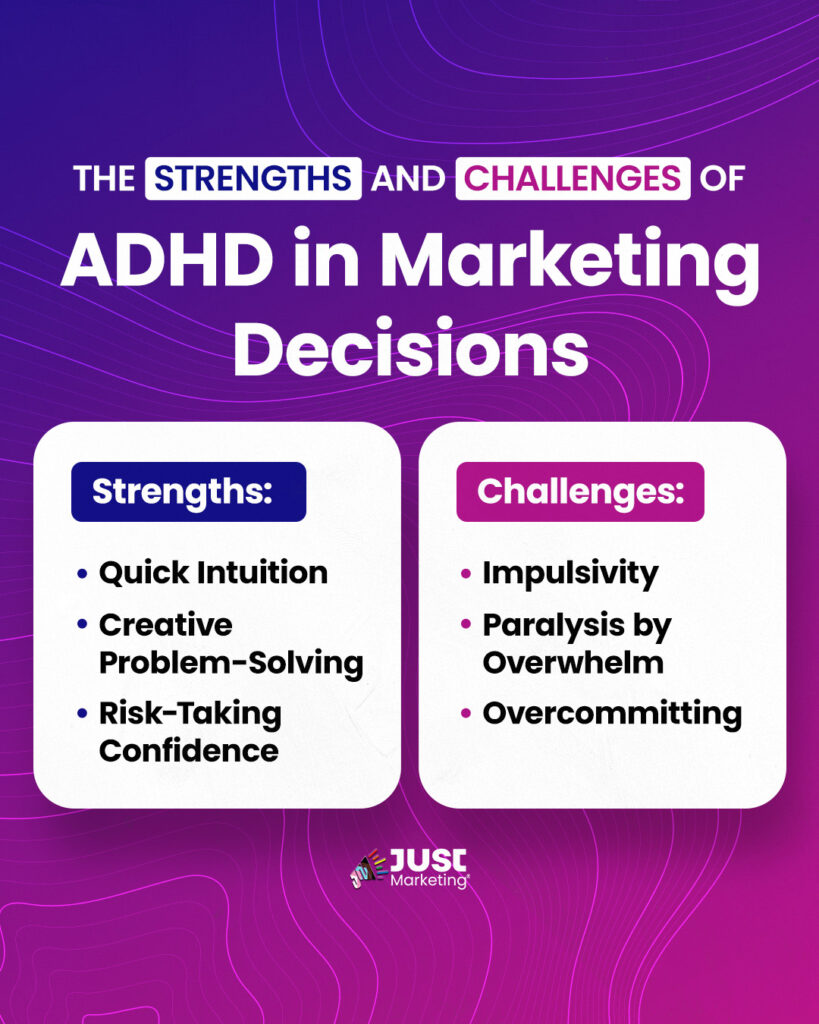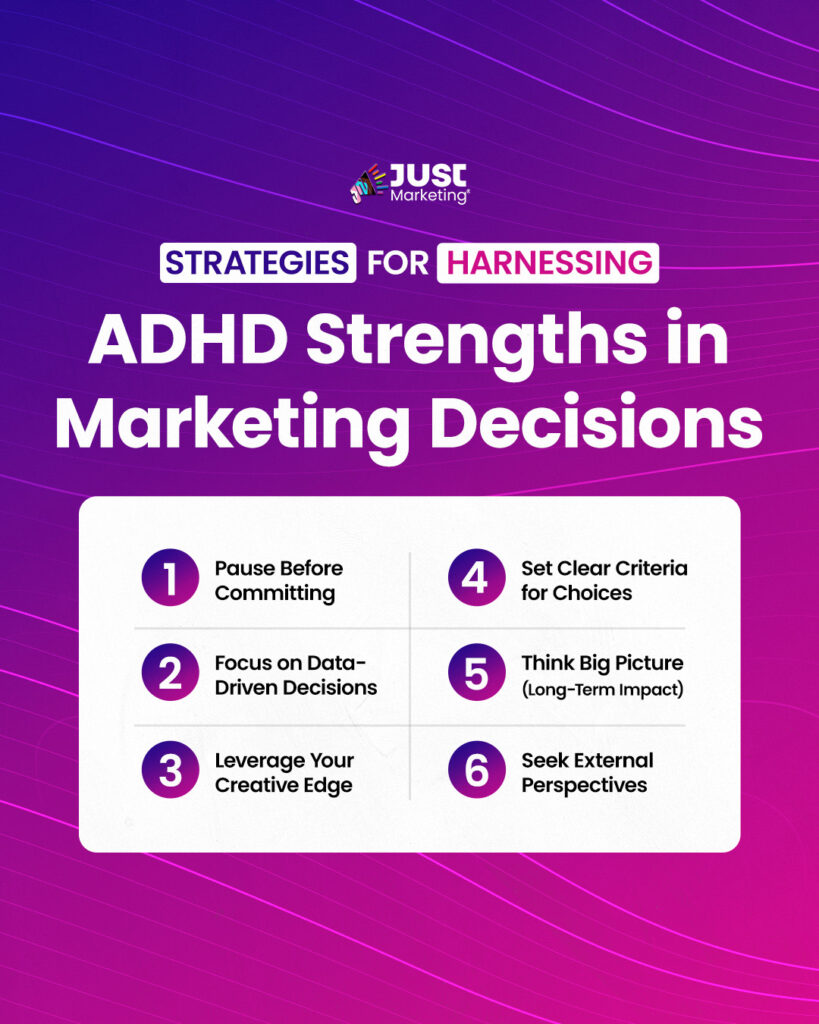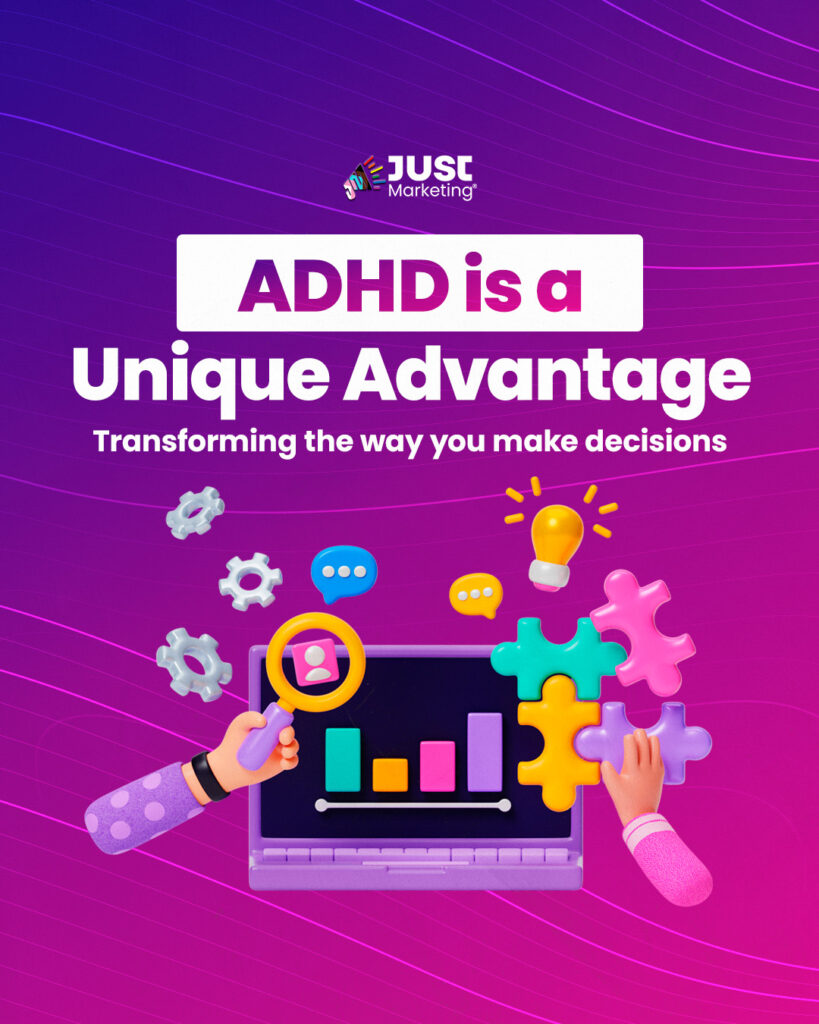As an entrepreneur with ADHD, making marketing decisions can feel like a double-edged sword. On one hand, you’re quick-thinking, creative, and ready to dive headfirst into bold ideas. On the other hand, impulsivity and overwhelm can sometimes derail even the best intentions. Sound familiar?
Here’s the good news: When you understand how your brain works and embrace the strengths ADHD brings to the table, you can make marketing decisions that not only stand out but also drive results.
In this blog, we’ll dive into the unique strengths and challenges ADHD entrepreneurs face in decision-making, particularly when it comes to marketing. We’ll also explore practical strategies to help you harness your ADHD superpowers to build campaigns and strategies that truly shine.
Let’s turn what you may see as a challenge into your secret weapon for marketing success!
The Strengths and Challenges of Making Marketing Decisions with ADHD

ADHD brings a unique blend of strengths and challenges to the decision-making process, especially in marketing. Understanding both sides of the coin is the key to turning potential hurdles into opportunities.
| ADHD Strengths in Marketing Decisions | ADHD Challenges in Marketing Decisions |
|---|---|
| Quick Intuition ADHD brains thrive in fast-paced environments, making you naturally skilled at thinking on your feet. This ability allows you to adapt quickly to changing trends and market demands, often putting you ahead of the curve. | Impulsivity While acting quickly can be a strength, it can also lead to decisions made without enough information or planning. This can result in wasted resources or missed opportunities to fine-tune a strategy for better results. |
| Creative Problem-Solving Your mind’s ability to connect seemingly unrelated dots is a superpower when brainstorming innovative marketing strategies. While others stick to tried-and-true methods, you’re coming up with ideas that are fresh, exciting, and uniquely your own. | Paralysis by Overwhelm With a million ideas swirling in your head, narrowing down your options can feel impossible. This can lead to analysis paralysis, leaving you stuck and unsure of where to start. |
| Risk-Taking Confidence What others may see as impulsivity can translate into bravery for you. Your willingness to experiment with bold campaigns or unconventional approaches can help you stand out in a crowded marketplace. | Overcommitting Your enthusiasm for exciting new ideas might lead you to say “yes” to too many opportunities. The result? You’re stretched too thin to give each project the attention it deserves, which can impact execution and outcomes. |
By recognizing these strengths and challenges, you can harness what makes your ADHD brain special while implementing strategies to counterbalance the hurdles.
Strategies for Harnessing ADHD Strengths in Marketing Decisions

Let’s explore actionable strategies to help you harness your strengths, mitigate your challenges, and make marketing decisions that feel aligned, effective, and uniquely you.
1. Pause Before Committing
ADHD brains are wired for action. While this instinct can spark bold, creative moves, it can also lead to decisions made in the heat of the moment—decisions you might wish you’d reconsidered once the excitement wears off. By pausing before committing to a choice, you give yourself the opportunity to shift from reaction to reflection. This pause creates space for deliberate, thoughtful decision-making that aligns with your goals and values.
Pausing doesn’t have to mean grinding your momentum to a halt. Instead, it’s about building micro-moments of reflection into your process:
- Set a Countdown Timer: When faced with a decision, set a timer for 10–15 minutes (or longer if the choice is complex). Use this time to step back and assess the situation before committing.
- Take a Short Walk: Physical movement can help your brain process emotions and ideas more clearly. Even a quick lap around the room can create enough distance to reset your perspective.
- Journal Your Thoughts: Write down what excites you about the decision, what concerns you, and how it fits into your overall goals. This simple act of putting thoughts on paper often reveals insights you might have overlooked.
By intentionally pausing, you’ll gain clarity and confidence, ensuring your decisions are grounded in strategy, not impulsivity.
2. Focus on Data-Driven Decisions
As an ADHD entrepreneur, your intuition is a powerful asset, helping you make quick decisions and take creative leaps. However, relying solely on gut feelings can sometimes lead to choices that don’t fully align with your goals or miss key opportunities. Incorporating data into your decision-making process balances your natural instincts with concrete evidence, ensuring your choices are both inspired and informed.
Grounding your decisions in data doesn’t mean stifling your creativity—it’s about giving your ideas a solid foundation. Here’s how to make data work for you:
- Use Analytics Tools: Platforms like Google Analytics, social media insights, or email marketing dashboards can provide a clear picture of what’s working and what’s not. Before launching a new campaign or strategy, review the metrics to identify trends or areas of opportunity.
- Create Checklists: Develop a simple checklist of questions to review before committing to a decision. For example:
- What does the data say about this idea?
- Have similar approaches worked well in the past?
- How does this align with current audience needs or preferences?
- Set Measurable Goals: Define specific outcomes you want to achieve with your decision. Instead of saying, “I want more engagement,” aim for something tangible like “Increase Instagram engagement by 20% in the next month.” Use this goal to evaluate whether your decision supports your desired results.
Data doesn’t replace your intuition—it enhances it. By combining your creative instincts with measurable insights, you can make marketing decisions that are both bold and backed by evidence.
3. Leverage Your Creative Edge
ADHD brains excel at seeing connections where others might not, making you a natural innovator. This creative edge thrives on novelty, helping you develop marketing ideas that stand out in a crowded marketplace. By intentionally tapping into this strength, you can create campaigns that captivate your audience and reflect your unique perspective.
Harnessing your creativity requires creating an environment that encourages and structures your brainstorming process. Here’s how:
- Schedule Dedicated Brainstorming Sessions: Set aside time specifically for idea generation, free from distractions. Use tools like mind maps, sticky notes, or digital apps to capture your thoughts visually and keep the process fun.
- Explore Unconventional Strategies: Think outside the box when planning campaigns. Could you use humor, storytelling, or unexpected formats like memes or user-generated content? Give yourself permission to experiment.
- Collaborate with Others: Partnering with a colleague or friend can help refine your ideas while adding fresh perspectives. ADHD creativity often thrives in collaborative settings where energy and ideas bounce off each other.
- Capture Inspiration as It Strikes: ADHD creativity isn’t limited to formal brainstorming sessions. Keep a notebook, app, or voice memo handy to jot down ideas whenever they hit. You’ll build a treasure trove of inspiration to revisit later.
Your creative edge is an advantage that can help your marketing not just succeed but shine. By giving your ideas structure and space to flourish, you’ll turn your novelty-driven thinking into strategies that captivate and convert.
4. Set Clear Criteria for Choices
When you have ADHD, the flood of ideas can feel exhilarating—but it can also be overwhelming. Without a clear framework, it’s easy to get lost in the excitement of possibilities, leading to choices that don’t align with your goals or stretch your capacity too thin. Setting clear criteria helps cut through the chaos, giving you structure and focus to evaluate options effectively.
Creating a simple decision-making framework can guide your choices, ensuring they’re intentional and strategic. Here’s how to implement it:
- Use a Decision Template: Develop a go-to list of questions to evaluate each idea or opportunity. For example:
- Does this align with my long-term business goals?
- What’s the potential return on investment (ROI)?
- How much time, energy, or resources will this require?
- Are there any risks I need to consider?
- Prioritize What Matters Most: Decide on non-negotiable criteria for your choices. For instance, if aligning with your values is essential, weigh that heavily in your decision-making process.
- Visualize the Impact: Use tools like a pros-and-cons list or a simple scoring system to compare options. Assign scores based on how well each idea meets your criteria, helping you objectively identify the best fit.
- Keep It Accessible: Save your template in a place where you can easily access it—whether that’s a physical notebook, a notes app, or a digital tool. Making it easy to refer to ensures you’ll actually use it when decisions arise.
By setting clear criteria, you can turn your big-picture vision into actionable steps, ensuring that your decisions support your goals while respecting your capacity. It’s not about limiting your creativity—it’s about channeling it into choices that move you forward.
5. Think Big Picture (Long-Term Impact)
ADHD brains are wired for excitement and novelty, which makes it tempting to chase short-term wins or quick gratification. However, marketing success often requires playing the long game. By focusing on the big picture, you ensure that your decisions not only feel good in the moment but also contribute to sustainable growth and long-term goals.
Shifting your focus to long-term impact doesn’t mean ignoring short-term results—it’s about balancing immediate needs with future outcomes. Here’s how to make this perspective part of your decision-making process:
- Tie Decisions to Your Goals: Before committing to an idea, ask yourself:
- Does this align with my long-term business vision?
- How will this decision help me achieve my key goals over the next six months, year, or beyond?
Writing these goals down and keeping them visible can help you stay focused on the bigger picture.
- Project Future Outcomes: Consider how your choice will play out over time. For example:
- Will this decision build lasting connections with my audience?
- How will I feel about this decision a month or a year from now?
Taking a moment to project the impact can help you avoid decisions driven by fleeting excitement.
- Schedule Regular Reviews: Block time monthly or quarterly to evaluate how your recent decisions have impacted your progress toward long-term goals. This habit allows you to adjust your strategies and ensures your decisions remain aligned with your overarching vision.
By keeping the long-term impact in mind, you can make choices that support lasting success and growth. It’s about creating a balance—honoring the thrill of the present while building a foundation for the future.
6. Seek External Perspectives
ADHD can make it difficult to see the full picture when you’re deep in the decision-making process. Whether it’s hyperfocus on one detail or impulsivity driving a choice, blind spots can creep in. Seeking external perspectives from trusted mentors, peers, or accountability partners helps counteract these blind spots, offering fresh insights and helping you avoid potential pitfalls.
Collaboration doesn’t mean giving up control of your decisions—it’s about using outside input to strengthen your ideas. Here’s how to incorporate this into your process:
- Identify Trusted Allies: Build a network of people you trust—mentors, colleagues, or even friends—who understand your goals and can provide honest, constructive feedback.
- Share Your Thought Process: When seeking input, explain your ideas, goals, and concerns clearly. Transparency allows others to offer feedback that’s both relevant and actionable.
- Ask the Right Questions: Guide the conversation with specific questions like:
- Do you see any risks I might be missing?
- How does this idea align with my long-term goals?
- What’s your honest opinion of this approach?
- Be Open to Feedback: ADHD can make rejection or criticism feel personal, but remember that external input is meant to help, not hinder. Focus on the value of the insight rather than how it’s delivered.
- Use Accountability to Stay Grounded: Regular check-ins with an accountability partner can help you pause, reflect, and refine decisions before acting on them.
By tapping into the wisdom and perspectives of others, you’ll create a more balanced, informed decision-making process. External insights don’t diminish your creativity—they enhance it, providing a safety net for your boldest ideas.
Next Steps: Make Better Marketing Decisions with ADHD

ADHD isn’t a limitation—it’s a unique advantage that can transform the way you make marketing decisions. By understanding your strengths, navigating your challenges, and implementing intentional strategies, you can channel your creativity, intuition, and energy into decisions that align with your goals and drive meaningful results.
Remember, the key is to work with your brain, not against it, so that you can make marketing decisions that feel both bold and strategic.
If you found these tips helpful, there’s plenty more where that came from! Subscribe to the blog to stay inspired with ADHD-friendly marketing strategies.

